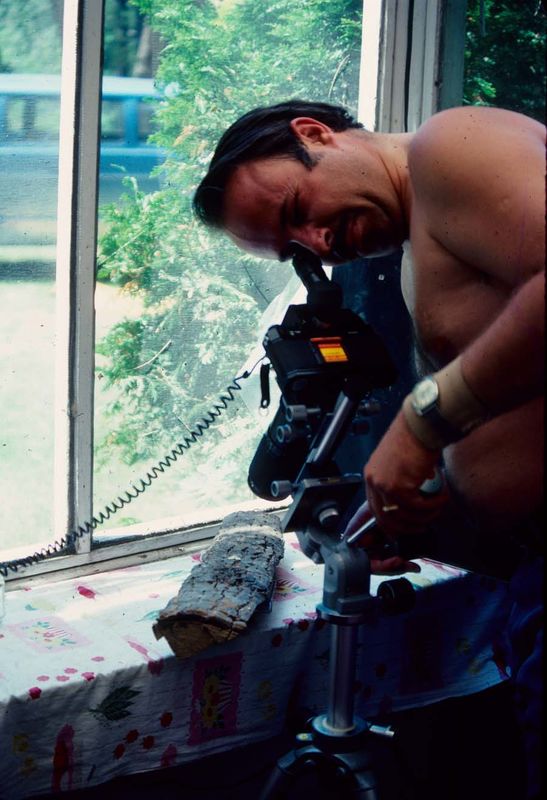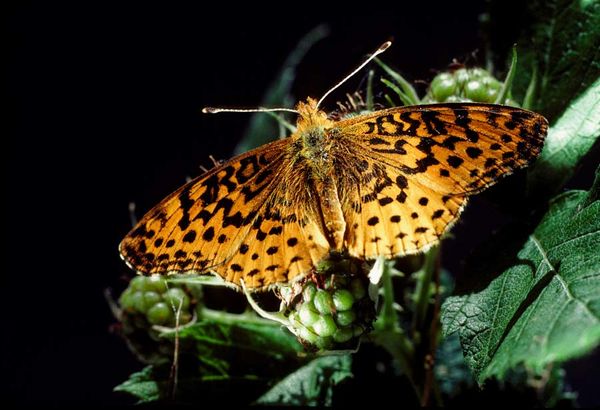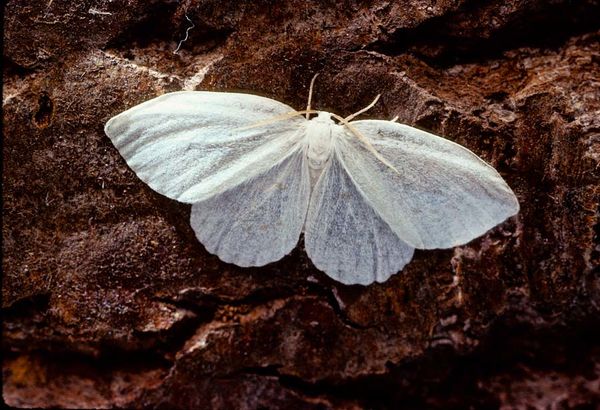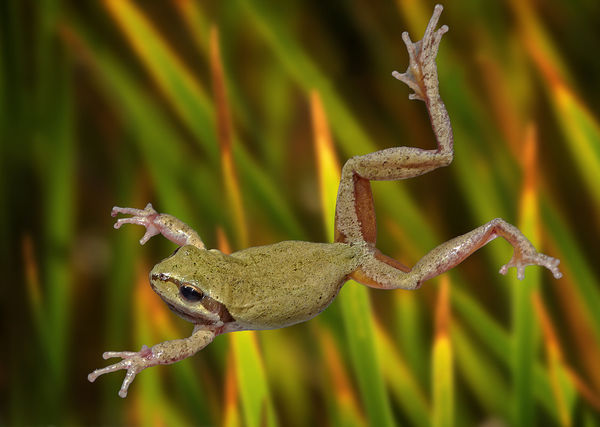Working with Cold Insects
Dec 13, 2016 11:40:51 #
Bugfan
Loc: Toronto, Canada
When you are first trying to capture insects with your camera you get the feeling that it's an impossible dream. So beginners are often the ones I teach these techniques to.
Insects are cold blooded so the colder they get the slower they are. Make yourself a butter fly net or buy one. Use this to capture your subjects. Once you have one, lace it into a jar that has a few air holes. Close the jar and place it in the fridge. How long it should remain there depends on the insect. Something huge and fat like a bumble bee or a large beetle, could well take an overnight stay in the fridge. Thinner insects like flies can be cooled in a few hours. Check out your subject every half hour or so until you find it has problems trying to stick to the walls of the jar, that's kind of an indicator that it's time to get it out.
As you are waiting for this moment it's time to set up your shot. Years ago I used to do this on a screened porch at a cottage I had. This way if the subject suddenly took off I could recapture it, cool it down again and fire off a few more shots. There was one corner on that porch that was in full sun for a few hours that I could use to illuminate my subject.
The first step was to set up the shot. I'd select an appropriate background which contrasted with the subject and was soemthing one would find the subject resting on. It doesn't have to be big of course and you don't have to worry about where you place it since you will only capture a small piece of the background anyway. A log of my backgrounds used to be bark from a wood pile outside. Sometimes I used leaves or small twigs. These I'd place in water to keep them from wilting before I was finished.
That arranged it was time to set up the lighting. I know where my subject is going to be so I got some small mirrors to illuminate this place. The mirrors are the kind women use to put on makeup usually. These I used to direct sinlight to my shot. I'd them place a peanut or some other small thing in that position since I still had to set up the camera.
Once the lighting was done it was camera set up time. A lot of this work happened in my film days when I was shooting 25 ASA Kodachrome slides. In those days I also couldn't afford a lot of flash units but then I didn't like them anyway, I got more colour and warmth from the sun. In my case setting up the camera was to set up a bellows. On the back I'd place an extension tube or two as well. On the front I'd place a macro lens. Then I'd focus on my peanut and take care of my exposure settings including depth of field.
With all that in place now, it was time to get my subject from the fridge. At this point it's vital that you are very gentle with the subject and that depending on what it is, to handle it with care. Generally I kept three different stamp tweezers handy for lifting the subject out and placing it on the shot. With some things like butterflies if you handle them you'll damage the scales and thus wreck your subject. Since I used subshine to illuminate my subject, I also opened an umbrella to put everything in shade as I set up the shot.
Once the subject is in the shot now I quickly adjust focus. Then I removed the umbrella and checked my exposure. And at that point I waited. The sunshine from the mirrors would wake up my subject relatively quickly. The first thing that happens usually within a minute is the subject will stand up. That's the time to fire off a few shots to get a natural shot. A minute after that the subject begins to shiver to warm up more. There is no point trying to take a picture of that, you'll only get a blurred shot. However, stand by, the shivering is brief, less than a minute and once it stops you've got about thirty seconds to capture a few more shots before the bu walks our of your rame or flies away.
Once it's outside the frame you can recapture it and put it back in the fridge or you can let it go depending on whether you think you have the shot or not.
In terms of cautions, insects like wasps can be dangerous. Always keep your buterfly net handy just in case, that's the best way to avoid being stung. Butterflies and moths are very delicate, never touch them with your hands or fingers, you'll damage the scales. Know what you are photographing, sometimes a bug can be very dangerous even when it's little. Learn something about insect behaviour so you can anticipate what will happen next.
If you're not into insects but more into flowers, those I always place in water because cutting them on a hot day will make them wilt quickly. The set up and everything else is the same as for the bugs, how elaborate it all is depends a lot on the size of your subject. The nice thin about the flowers is that they sit there for you and they won't walk or fly away.
This is the kind of set up that I used to use ... and following that are some of the results.
Insects are cold blooded so the colder they get the slower they are. Make yourself a butter fly net or buy one. Use this to capture your subjects. Once you have one, lace it into a jar that has a few air holes. Close the jar and place it in the fridge. How long it should remain there depends on the insect. Something huge and fat like a bumble bee or a large beetle, could well take an overnight stay in the fridge. Thinner insects like flies can be cooled in a few hours. Check out your subject every half hour or so until you find it has problems trying to stick to the walls of the jar, that's kind of an indicator that it's time to get it out.
As you are waiting for this moment it's time to set up your shot. Years ago I used to do this on a screened porch at a cottage I had. This way if the subject suddenly took off I could recapture it, cool it down again and fire off a few more shots. There was one corner on that porch that was in full sun for a few hours that I could use to illuminate my subject.
The first step was to set up the shot. I'd select an appropriate background which contrasted with the subject and was soemthing one would find the subject resting on. It doesn't have to be big of course and you don't have to worry about where you place it since you will only capture a small piece of the background anyway. A log of my backgrounds used to be bark from a wood pile outside. Sometimes I used leaves or small twigs. These I'd place in water to keep them from wilting before I was finished.
That arranged it was time to set up the lighting. I know where my subject is going to be so I got some small mirrors to illuminate this place. The mirrors are the kind women use to put on makeup usually. These I used to direct sinlight to my shot. I'd them place a peanut or some other small thing in that position since I still had to set up the camera.
Once the lighting was done it was camera set up time. A lot of this work happened in my film days when I was shooting 25 ASA Kodachrome slides. In those days I also couldn't afford a lot of flash units but then I didn't like them anyway, I got more colour and warmth from the sun. In my case setting up the camera was to set up a bellows. On the back I'd place an extension tube or two as well. On the front I'd place a macro lens. Then I'd focus on my peanut and take care of my exposure settings including depth of field.
With all that in place now, it was time to get my subject from the fridge. At this point it's vital that you are very gentle with the subject and that depending on what it is, to handle it with care. Generally I kept three different stamp tweezers handy for lifting the subject out and placing it on the shot. With some things like butterflies if you handle them you'll damage the scales and thus wreck your subject. Since I used subshine to illuminate my subject, I also opened an umbrella to put everything in shade as I set up the shot.
Once the subject is in the shot now I quickly adjust focus. Then I removed the umbrella and checked my exposure. And at that point I waited. The sunshine from the mirrors would wake up my subject relatively quickly. The first thing that happens usually within a minute is the subject will stand up. That's the time to fire off a few shots to get a natural shot. A minute after that the subject begins to shiver to warm up more. There is no point trying to take a picture of that, you'll only get a blurred shot. However, stand by, the shivering is brief, less than a minute and once it stops you've got about thirty seconds to capture a few more shots before the bu walks our of your rame or flies away.
Once it's outside the frame you can recapture it and put it back in the fridge or you can let it go depending on whether you think you have the shot or not.
In terms of cautions, insects like wasps can be dangerous. Always keep your buterfly net handy just in case, that's the best way to avoid being stung. Butterflies and moths are very delicate, never touch them with your hands or fingers, you'll damage the scales. Know what you are photographing, sometimes a bug can be very dangerous even when it's little. Learn something about insect behaviour so you can anticipate what will happen next.
If you're not into insects but more into flowers, those I always place in water because cutting them on a hot day will make them wilt quickly. The set up and everything else is the same as for the bugs, how elaborate it all is depends a lot on the size of your subject. The nice thin about the flowers is that they sit there for you and they won't walk or fly away.
This is the kind of set up that I used to use ... and following that are some of the results.



Dec 13, 2016 12:22:36 #
Thank you for sharing your technique for invert captures. K-25 and 64. Those were the days. Now we have the image results instantly. I am still using the macro lenses I purchased 35 years ago though. 

Dec 13, 2016 12:47:37 #
Bugfan
Loc: Toronto, Canada
You're most welcome. Those were challenging days. It was a week before you could find out how you did since Kodachrome had to be sent out for processing. And by the time the images came back you no longer remembered what you had done. Add to that, I was routinely doing thirty second exposures at high noon, another challenge particularly with an active subject. But it was fun and I learned a hell of a lot from it all that makes digital a lot simpler for me these days.
I should also add, while I still use my bellows once in a while, with digital I find I don't need to usually. In addition to a Nikon D3, I also have a Nikon D800 which I bought exclusively for macro. Between that camera's resolution and my macro lenses I find that I can easily enlarge my subjects without the need for a bellows and all the complexities that demands. That has also been a welcome change. However, I won't give it up. A few years back I was sitting at my back table adjusting my bellows and trying to focus on a tiny flower when something moved in my image. I looked to see what it was. It turned out to be a hover fly that decided to have some lunch on the flower I was trying to photograph. Needless to say the priority changed and I immediately focussed on the hover fly. That got me some amazing images. Had I wanted to deliberatly capture that hover fly with my bellows it would never have happened. There was a lesson here too. Set up your gear near flowers and always be prepared for an unexpected visitor. You never know when you might get lucky again.
I should also add, while I still use my bellows once in a while, with digital I find I don't need to usually. In addition to a Nikon D3, I also have a Nikon D800 which I bought exclusively for macro. Between that camera's resolution and my macro lenses I find that I can easily enlarge my subjects without the need for a bellows and all the complexities that demands. That has also been a welcome change. However, I won't give it up. A few years back I was sitting at my back table adjusting my bellows and trying to focus on a tiny flower when something moved in my image. I looked to see what it was. It turned out to be a hover fly that decided to have some lunch on the flower I was trying to photograph. Needless to say the priority changed and I immediately focussed on the hover fly. That got me some amazing images. Had I wanted to deliberatly capture that hover fly with my bellows it would never have happened. There was a lesson here too. Set up your gear near flowers and always be prepared for an unexpected visitor. You never know when you might get lucky again.
Dec 13, 2016 13:31:05 #
Bugfan wrote:
You're most welcome. Those were challenging days. ... (show quote)
Yes, it is always shooting for the moment. The same technique works with cold-blooded vertebrates as well. It provides one with time to set up for the shot.
Dec 13, 2016 13:54:01 #
Chilling down the subject is something that I have tried from time to time, although I have never tried to chill them nearly as long as you have.
Since these are active insects, I find they do revive rather quickly but while they start to regain some mobility their movements cause them to have some unnatural poses.
Since these are active insects, I find they do revive rather quickly but while they start to regain some mobility their movements cause them to have some unnatural poses.
If you want to reply, then register here. Registration is free and your account is created instantly, so you can post right away.


